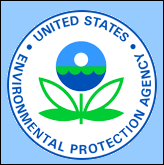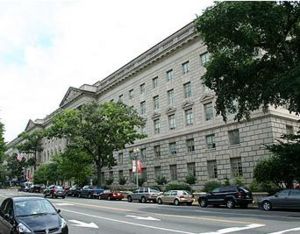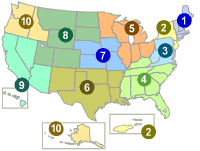U.S. Environmental Protection Agency: Difference between revisions
imported>Milton Beychok m (Added {{subpages}}) |
mNo edit summary |
||
| (40 intermediate revisions by 7 users not shown) | |||
| Line 2: | Line 2: | ||
[[Image:EPA Logo.gif|right|thumb|164px|{{#ifexist:Template:EPA Logo.gif/credit|{{EPA Logo.gif/credit}}<br/>|}}The official seal of the the U.S. EPA.<ref>[http://www.epa.gov/history/org/origins/seal.htm The EPA Seal]</ref>]] | [[Image:EPA Logo.gif|right|thumb|164px|{{#ifexist:Template:EPA Logo.gif/credit|{{EPA Logo.gif/credit}}<br/>|}}The official seal of the the U.S. EPA.<ref>[http://www.epa.gov/history/org/origins/seal.htm The EPA Seal]</ref>]] | ||
The ''' | The '''U.S. Environmental Protection Agency''' ('''EPA''' or '''U.S. EPA''') is an independent agency of the [[Government of the United States of America]] created by an executive order of President [[Richard Nixon]] in 1970 and is part of the executive branch of the government.<ref> It was not created by act of Congress. [http://www.epa.gov/history/publications/origins6.htm Origins of the EPA: An Agency For The Environment]]</ref> Its official name is the '''Environmental Protection Agency''' and it reports directly to the president. The primary mission of the EPA is to protect human health and safeguard the [[natural environment]] (air, water and land) of the nation.<ref name=History>[http://www.epa.gov/history/ EPA History Home]</ref> | ||
The EPA was established to combine into a single agency many of the existing federal government activities of research and development, monitoring, setting of standards, compliance and enforcement related to protection of the environment. | The EPA was established to combine into a single agency many of the existing federal government activities of research and development, monitoring, setting of standards, compliance and enforcement related to protection of the [[Natural environment|environment]]. | ||
Since 2000 the budget has held fairly steady at $7.6 to $8.4 billion (with no adjustment for inflation). In terms of objectives, 13% is budgeted for clean air and global climate change, 36% for clean and safe water, 24% for land preservation and restoration, 17% for healthy communities and ecosystems, and 11% for compliance and [[Natural environment|environmental]] stewardship.<ref>See [http://www.epa.gov/budget/2009/final_09_bib%20.pdf 2009 EPA Budget]</ref> In 2008 it has a staff of about 18,000 people in headquarters and departmental or divisional offices, 10 regional offices, and over 25 laboratories located across the nation. More than half of the staff are engineers, scientists and environmental protection specialists. The others include legal counsel, financial, public affairs and computer specialists. | |||
== | ==History== | ||
[[Image:EPA Building.jpg|right|thumb|300px|{{#ifexist:Template:EPA Building.jpg/credit|{{EPA Building.jpg/credit}}<br/>|}}EPA Building in Washington, DC<ref>[http://riverfall.blogspot.com/2007/06/washington-dc-day-3.html The EPA Building]</ref>]] | [[Image:EPA Building.jpg|right|thumb|300px|{{#ifexist:Template:EPA Building.jpg/credit|{{EPA Building.jpg/credit}}<br/>|}}EPA Building in Washington, DC<ref>[http://riverfall.blogspot.com/2007/06/washington-dc-day-3.html The EPA Building]</ref>]] | ||
Kraft<ref name=Kraft>{{cite journal|last=Kraft|first=Michael E.|authorlink=|title=U.S. Environmental Policy and Politics: from the 1960s to the 1990s|journal=Journal of Policy History |volume= 12|issue=1|pages=17-42|date=2000|id=ISSN 0898-0306}}</ref> examines the rise and evolution of environmental politics since the 1960s. Originating as a movement built around the conservation of natural resources and an attempt to stave off air, water, and land pollution, environmentalism evolved into a much more sophisticated control regime, one that employed the Environmental Protection Agency to slow environmental degradation. | |||
President [[Richard Nixon]], on July 9, 1970, told Congress of his plan to create the EPA by combining parts of three federal departments, three bureaus, three administrations and many other offices into the new single, independent agency to be known as the '''Environmental Protection Agency'''.<ref name=History/> Congress had 60 days to reject the proposal, but opinion was favorable and the reorganization took place without legislation. On December 2, 1970, the EPA was officially established and began operation under director William Ruckelshaus. The EPA began by consolidating 6550 employees from different agencies into a new agency with a $1.4 billion budget. | |||
Kraft<ref name=Kraft/> notes that despite its limited charter from 1970, over time EPA has expanded its regulatory function and jousted with the forces of business and economic development. Kraft considers the next major transition in environmental policy to be the process of insuring the "sustainability" of resources through a coalition of interests ranging from policymakers to business leaders, scholars, and individual citizens. At the turn of the 21st century, these often competing groups were wrestling with disparate environmental, economic, and social values. | |||
Russell<ref>{{cite journal|last=Russell, III|first=Edmund P.|title=Lost among the Parts per Billion: Ecological Protection at the United States Environmental Protection Agency, 1970-1993|journal=Environmental History |volume= 2|issue=1|pages=29-51|date=1997|id=ISSN 1084-5453}}</ref>shows that from 1970 to 1993, the EPA devoted more of its resources to human health issues, notably cancer prevention, than to the protection of nonhuman species. The limited scope of environmental protection was due to a variety of reasons. An institutional culture favored human health issues because most employees were trained in this area. The emphasis on cancer came from the legal division's discovery that judges were more persuaded by arguments about the carcinogenicity of chemicals than by threats to nonhumans. The views of the agency leaders, who followed politically realistic courses, also played an important part in shaping the EPA's direction. Those supporting ecological issues acquired a new tool in the 1980s with the development of risk assessments so that advocates of ecological protection could use language framed by advocates of human health to protect the environment. | |||
==Major laws administered by the EPA== | |||
The EPA administers over a dozen major environmental laws including:<ref>[http://www.eoearth.org/article/Environmental_Protection_Agency,_United_States Environmental Protection Agency, United States] Ralph Stuart, Peter Saundry and Sidney Draggan (Contributing Authors); Richard Reibstein (Topic Editor), 2008. ''Environmental Protection Agency, United States.'' From the website of the Encyclopedia of Earth. Retrieved January 28, 2008].</ref> | |||
* [[Clean Air Act (U.S.)|Clean Air Act]] | |||
* [[Clean Water Act (U.S.)|Clean Water Act]] | |||
* [[Comprehensive Environmental Response, Compensation, and Liability Act]] (CERCLA, also known as Superfund) and [[Superfund Amendments and Reauthorization Act]] (SARA) | |||
* [[Emergency Planning & Community Right-to-Know Act]] | |||
* [[Federal Insecticide, Fungicide & Rodenticide Act]] (FIFRA) and Federal Food, Drug, and Cosmetic Act (FFDCA) | |||
* [[National Environmental Policy Act]] (NEPA) | |||
* [[Oil Pollution Act]] of 1990 | |||
* [[Safe Drinking Water Act]] | |||
* [[Solid Waste Disposal Act]] and [[Resource Conservation & Recovery Act]] (RCRA) | |||
* [[Toxic Substances Control Act]] (TSCA) | |||
==Organization of the EPA== | ==Organization of the EPA== | ||
| Line 26: | Line 43: | ||
** Office of the General Counsel | ** Office of the General Counsel | ||
** Office of the Inspector General | ** Office of the Inspector General | ||
* Assistant | * Assistant Administrators for | ||
* | **Administration and Resources Management | ||
* | **Enforcement and Compliance Assurance | ||
* | **International Affairs | ||
* | **Environmental Information | ||
* | **Air and Radiation | ||
* | **Water | ||
* | **Prevention, Pesticides and Toxic Substances | ||
* | **Research and Development | ||
**Solid Waste and Emergency Response | |||
{{Image|EPA Regions.gif|right|200px|Map of the U.S. EPA Regions}} | |||
* Regional offices<ref name=Org/> | * Regional offices<ref name=Org/> | ||
** Region 1 (Boston) Serving Connecticut, Maine, Massachusetts, New Hampshire, Rhode Island, Vermont & 10 Tribal Nations | ** Region 1 (Boston) Serving Connecticut, Maine, Massachusetts, New Hampshire, Rhode Island, Vermont & 10 Tribal Nations | ||
| Line 47: | Line 68: | ||
** Region 10 (Seattle) Serving Alaska, Idaho, Oregon, Washington and Native Tribes | ** Region 10 (Seattle) Serving Alaska, Idaho, Oregon, Washington and Native Tribes | ||
== | == Air Quality Modeling Group == | ||
{{main|Air Quality Modeling Group}} | |||
The | The Air Quality Modeling Group (AQMG) is part of the Office of Air Quality Planning and Standards in the U.S. EPA's Office of Air and Radiation (OAR) and provides leadership and direction on the full range of air quality models, [[Air pollution dispersion modeling|air pollution dispersion models]] and other mathematical simulation techniques used in assessing pollution control strategies and the impacts of air pollution sources. | ||
The AQMG is located in Research Triangle Park, North Carolina. | |||
==References== | ==References== | ||
{{reflist}} | {{reflist}} | ||
[[Category: | [[Category:Suggestion Bot Tag]] | ||
Latest revision as of 17:01, 31 October 2024
The U.S. Environmental Protection Agency (EPA or U.S. EPA) is an independent agency of the Government of the United States of America created by an executive order of President Richard Nixon in 1970 and is part of the executive branch of the government.[2] Its official name is the Environmental Protection Agency and it reports directly to the president. The primary mission of the EPA is to protect human health and safeguard the natural environment (air, water and land) of the nation.[3]
The EPA was established to combine into a single agency many of the existing federal government activities of research and development, monitoring, setting of standards, compliance and enforcement related to protection of the environment.
Since 2000 the budget has held fairly steady at $7.6 to $8.4 billion (with no adjustment for inflation). In terms of objectives, 13% is budgeted for clean air and global climate change, 36% for clean and safe water, 24% for land preservation and restoration, 17% for healthy communities and ecosystems, and 11% for compliance and environmental stewardship.[4] In 2008 it has a staff of about 18,000 people in headquarters and departmental or divisional offices, 10 regional offices, and over 25 laboratories located across the nation. More than half of the staff are engineers, scientists and environmental protection specialists. The others include legal counsel, financial, public affairs and computer specialists.
History
Kraft[6] examines the rise and evolution of environmental politics since the 1960s. Originating as a movement built around the conservation of natural resources and an attempt to stave off air, water, and land pollution, environmentalism evolved into a much more sophisticated control regime, one that employed the Environmental Protection Agency to slow environmental degradation.
President Richard Nixon, on July 9, 1970, told Congress of his plan to create the EPA by combining parts of three federal departments, three bureaus, three administrations and many other offices into the new single, independent agency to be known as the Environmental Protection Agency.[3] Congress had 60 days to reject the proposal, but opinion was favorable and the reorganization took place without legislation. On December 2, 1970, the EPA was officially established and began operation under director William Ruckelshaus. The EPA began by consolidating 6550 employees from different agencies into a new agency with a $1.4 billion budget.
Kraft[6] notes that despite its limited charter from 1970, over time EPA has expanded its regulatory function and jousted with the forces of business and economic development. Kraft considers the next major transition in environmental policy to be the process of insuring the "sustainability" of resources through a coalition of interests ranging from policymakers to business leaders, scholars, and individual citizens. At the turn of the 21st century, these often competing groups were wrestling with disparate environmental, economic, and social values.
Russell[7]shows that from 1970 to 1993, the EPA devoted more of its resources to human health issues, notably cancer prevention, than to the protection of nonhuman species. The limited scope of environmental protection was due to a variety of reasons. An institutional culture favored human health issues because most employees were trained in this area. The emphasis on cancer came from the legal division's discovery that judges were more persuaded by arguments about the carcinogenicity of chemicals than by threats to nonhumans. The views of the agency leaders, who followed politically realistic courses, also played an important part in shaping the EPA's direction. Those supporting ecological issues acquired a new tool in the 1980s with the development of risk assessments so that advocates of ecological protection could use language framed by advocates of human health to protect the environment.
Major laws administered by the EPA
The EPA administers over a dozen major environmental laws including:[8]
- Clean Air Act
- Clean Water Act
- Comprehensive Environmental Response, Compensation, and Liability Act (CERCLA, also known as Superfund) and Superfund Amendments and Reauthorization Act (SARA)
- Emergency Planning & Community Right-to-Know Act
- Federal Insecticide, Fungicide & Rodenticide Act (FIFRA) and Federal Food, Drug, and Cosmetic Act (FFDCA)
- National Environmental Policy Act (NEPA)
- Oil Pollution Act of 1990
- Safe Drinking Water Act
- Solid Waste Disposal Act and Resource Conservation & Recovery Act (RCRA)
- Toxic Substances Control Act (TSCA)
Organization of the EPA
The EPA has a number of departments or divisions as well as ten regional offices:[9]
- Administrator and Deputy Administrator
- Office of the Chief Financial Officer
- Office of the General Counsel
- Office of the Inspector General
- Assistant Administrators for
- Administration and Resources Management
- Enforcement and Compliance Assurance
- International Affairs
- Environmental Information
- Air and Radiation
- Water
- Prevention, Pesticides and Toxic Substances
- Research and Development
- Solid Waste and Emergency Response
- Regional offices[9]
- Region 1 (Boston) Serving Connecticut, Maine, Massachusetts, New Hampshire, Rhode Island, Vermont & 10 Tribal Nations
- Region 2 (New York) Serving New Jersey, New York, Puerto Rico, US Virgin Islands and 7 Tribal Nations
- Region 3 (Philadelphia) Serving Delaware, District of Columbia, Maryland, Pennsylvania, Virginia, and West Virginia
- Region 4 (Atlanta) Serving Alabama, Florida, Georgia, Kentucky, Mississippi, North Carolina, South Carolina, Tennessee and 6 Tribes
- Region 5 (Chicago) Serving Illinois, Indiana, Michigan, Minnesota, Ohio, Wisconsin and 35 Tribes
- Region 6 (Dallas) Serving Louisiana, Arkansas, Oklahoma, New Mexico, Texas and 65 Tribes
- Region 7 (Kansas City) Serving Iowa, Kansas, Missouri, Nebraska and 9 Tribal Nations
- Region 8 (Denver) Serving Colorado, Montana, North Dakota, South Dakota, Utah, Wyoming and 27 Tribal Nations
- Region 9 (San Francisco) Serving Arizona, California, Hawaii, Nevada, the Pacific Islands, and Tribal Nations
- Region 10 (Seattle) Serving Alaska, Idaho, Oregon, Washington and Native Tribes
Air Quality Modeling Group
The Air Quality Modeling Group (AQMG) is part of the Office of Air Quality Planning and Standards in the U.S. EPA's Office of Air and Radiation (OAR) and provides leadership and direction on the full range of air quality models, air pollution dispersion models and other mathematical simulation techniques used in assessing pollution control strategies and the impacts of air pollution sources.
The AQMG is located in Research Triangle Park, North Carolina.
References
- ↑ The EPA Seal
- ↑ It was not created by act of Congress. Origins of the EPA: An Agency For The Environment]
- ↑ 3.0 3.1 EPA History Home
- ↑ See 2009 EPA Budget
- ↑ The EPA Building
- ↑ 6.0 6.1 Kraft, Michael E. (2000). "U.S. Environmental Policy and Politics: from the 1960s to the 1990s". Journal of Policy History 12 (1): 17-42. ISSN 0898-0306.
- ↑ Russell, III, Edmund P. (1997). "Lost among the Parts per Billion: Ecological Protection at the United States Environmental Protection Agency, 1970-1993". Environmental History 2 (1): 29-51. ISSN 1084-5453.
- ↑ Environmental Protection Agency, United States Ralph Stuart, Peter Saundry and Sidney Draggan (Contributing Authors); Richard Reibstein (Topic Editor), 2008. Environmental Protection Agency, United States. From the website of the Encyclopedia of Earth. Retrieved January 28, 2008].
- ↑ 9.0 9.1 EPA Organizational Structure
- Editable Main Articles with Citable Versions
- CZ Live
- Engineering Workgroup
- Earth Sciences Workgroup
- Politics Workgroup
- Chemical Engineering Subgroup
- Environmental Engineering Subgroup
- Articles written in American English
- Advanced Articles written in American English
- All Content
- Engineering Content
- Earth Sciences Content
- Politics Content
- Chemical Engineering tag
- Environmental Engineering tag


